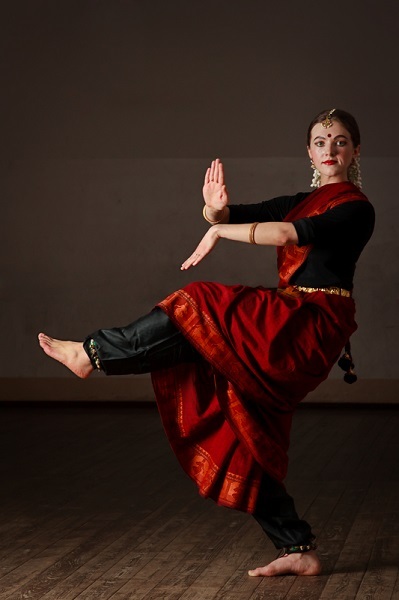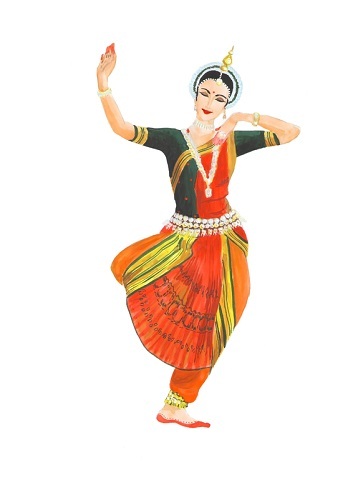

Shankuk, a Bharat Natyashastra lecturer, is mentioned in Abhinavabharati despite his argument not accepted. Sthayibhavas of characters imitated turn into Rasa while actors imitate, viewers deduce Sthayibhavas. He initially debunked the theories of genesis and the richness of creation. Sri Sankuka is greatly influenced by the logic and epistemology of the Nyaya Schools of Indian philosophy. Most of Sri Sankuka’s theory was founded on criticism of Lollata’s Rasa-theory because he did not think highly of most of Lollata’s efforts.

Dance Mudra
A Kashmiri Naiyayika from the ninth century AD, a younger contemporary of Lollata, was the second Rasa-theorist who advanced the Rasa-debate. Similar to Lollata, none of his works is still in existence, and everything we know about his thoughts comes from the writing of Hemachandra, Mammata, and Abhinavagupta.
Sri Sankuka harshly criticised the idea that sthayibhava production or intensification has no bearing on the nature of rasa. The Rasa is implied instead.
The sthayibhavas do not come naturally to the actor, but it is assumed that the trained actor will create a convincing imitation of sthayibhava with the combination of vibhavas, anubhavas, and vyabhicharis bhavas in addition to the unreal.
When the audience deduces the existence of Sthayi, Rasa becomes realised. It’s interesting to notice that this kind of cognition is distinct from every other recognised kind.
He uses the analogy of citra-turaga nyaya, which stands for the analogy through which one can discover that the horse in the picture is genuinely known as a horse, to further illustrate his thesis.
Sri Sankuka utterly destroyed Lollata’s Rasa theory to support his claims. In doing so, he attempted to address several queries put up by his capable processor and advanced the discussion.
Completely denying the central claim made by Lollata, according to which the effect of rasa is nothing more than an amplified sthayi brought on by the Vibhavas of the performers and characters.
Sri Sankuka harshly criticised the idea that sthayibhava production or intensification has no bearing on the nature of rasa the Rasa is implied instead.
He also brought out another important point: direction cognitions of sthayibhava are not possible; they can only be understood through their respective vibhavas, etc.
He also brought up the important point that it is impossible to understand the direction of sthayibhava; instead, it can only be understood by its vibhavas, etc.
In contrast to his processor, he frequently mentions spectators and discusses Rasa from the perspective of the savouring of spectators. In addition, he anticipates that his audience will be prepared to use their capacity for deduction at all times.
Clarified the connection between sthayibhava and vibhavas. Sri Sankuka made it very apparent that it is only through vibhavas that viewers can infer a sthayi in the actor that is not present.
The process of realising rasa is one of logical inference. According to Sri Sankuka, rasa is realised through an inference in which the vibhavas are anumapaka and rasa is anumapya.
Sthayibhava is true, enduring feelings that performers imitate. Sthayibhava imitation leads to Rasa. Actors are trained in the art of mimicry, and they copy the sthayibhavas through their synthetic portrayals. Finally, through the actors’ imitation, spectators can enjoy rasa.
The inference’s cognition is distinct; Sri Sankuka demonstrates this by using the analogy of & “citra-turaga-nyaya” to show that it is distinct from other types of cognition that are more widely known.
Raising the status of the audience was one of his theories that Bhatta Tanta and other later critics expressed strong reservations about. They found it very intolerable that Rasa was seen as a copy of Sthayi. Sri Sankuka’s intended interpretation of imitation was too constrained. Even his original suggestion to deduce sthayibhavas was untenable. Bhatta Nayaka drew attention to the fact that the character was not in front of the audience, making the inference impossible. Nevertheless, the issues he brought up and his stature as an artist elevated aided later thinkers in exploring Rasa more thoroughly and thoroughly.
Emphasised Sthayi Bhavas importance in the process of Rasa's realisation. Actors were maintained as active informants rather than passive receivers. The spectator’s means of knowledge, according to Shri Sankuka’s notion of rasa, is perception. The inference must be made from knowledge. The idea of reproduction is also present, requiring cognition of what the actor reproduces. This is a result of the spectator’s distance. The spectator’s consciousness must incorporate external cognition. It is not directly perceptible through speech or motion.
Q1. Name the Kashmiri scholar who is credited with the distinction of being the first one to initiate the philosophical discussion of Rasa-theory.
Ans. Name the Kashmiri scholar who is credited with the distinction of being the first one to initiate the philosophical discussion of Rasa-theory is Sri Sankuka.
Q2. What are the 8 rasas?
Ans.Corresponding to these mental states are eight Rasa −
Erotic - (Shringara)
Comic – (Hasya)
Pathetic – (kruna)
Furious – (Raudra)
Heroic – (Vira)
Terrible – (Bhayanaka)
Odious – (Bibhatasa)
Marvellous – (Adbhuta)
Q3. State Sri Sankuka’s central idea?
Ans. Sri Sankuka harshly criticised the idea that sthayi bhava production or intensification has no bearing on the nature of rasa the Rasa is implied instead. He also brought out another important point: direction cognitions of sthayi bhava are not possible; they can only be understood through their respective vibhavas, etc.